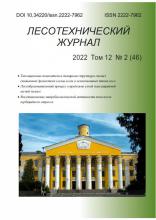Voronezh, Voronezh, Russian Federation
Voronezh, Voronezh, Russian Federation
Voronezh, Voronezh, Russian Federation
We studied morphological features of the structure of the profile of forest soils, their structural-aggregate composition, chemical, physical and chemical properties using standard methods. The differ-ences in the studied parameters depending on the position in the relief are defined. Research are pre-sented, which has high scientific and practical significance for studying the conditions of growth, spatial distribution, productivity, features of functioning of natural forest ecosystems and improving and detailing taxonomic position of soils of gulley and ravine complex.
ravine oak forests, ravines, edaphic conditions, forest soil formation, forest ecosystems, water erosion.
1. Devyatova T.A., Bozhko S.N. Ob osobennostyakh kartografirovaniya pochvennogo pokrova balochnykh vodosborov TsChR [About the features of the mapping of the soil cover of the ravine catchments CCR] Aktual'nye problemy pochvovedeniya, ekologii i zemledeliya: Sb. dokl. nauch.-prakt. konf. [Actual problems of soil science, ecology and agriculture: Collected papers] Kursk, 2010, рр. 27-32. (In Russian). EDN: https://elibrary.ru/VHEGTR
2. Devyatova T.A., Bozhko S.N. Izmenenie pochvennogo pokrova i svoystv pochv po elementam rel'efa balochnykh vodosborov Voronezhskoy oblasti [The change in soil cover and soil properties on elements elevation of the ravine catchments of the Voronezh region] Vestnik Voronezhskogo gosudarstvennogo universiteta. Ceriya Khimiya. Biologiya. Farmatsiya [Herald of the Voronezh State University. Series Chemistry. Biology. Pharmacy] Voronezh, 2012, no. 1, pp. 77-83. (In Russian). EDN: https://elibrary.ru/OZCXKF
3. Evchenko Yu.N. Faktory, vliyayushchie na ustoychivost' i produktivnost' bayrachnykh dubrav [Factors affecting the stability and productivity of oak forests of ravines] Vestnik Voronezhskogo gosudarstvennogo universiteta. Ceriya Geografiya. Geoekologiya [Herald of the Voronezh State University. Series Geography. Geoecology] Voronezh, 2007, no. 2, pp. 103-105. (In Russian). EDN: https://elibrary.ru/KAJWNZ
4. Ivanov V.D., Bozhko S.N. Pochvennyy pokrov i svoystva pochv balochnykh vodosborov Tsentral'no-Chernozemnogo regiona [Soil cover and soil properties of the ravine catchments of the Central Chernozem Region] Pochvovedenie [Soil Science] Moscow, 2000, no. 6, pp. 671-682. (In Russian). EDN: https://elibrary.ru/YGQSYL
5. Kharchenko N.A. Prirodnye usloviya proizrastaniya dubrav Tsentral'nogo Chernozem'ya [Natural growing conditions of the oak forests of the Central Chernozem Region] Degradatsiya dubrav Tsentral'nogo Chernozem'ya [The degradation of the oak forests of the Central Chernozem Region] Voronezh, 2010, pp. 71-168. (In Russian). EDN: https://elibrary.ru/YPGWJD
6. Mikhno V.B. Landshaftnyy aspekt proizrastaniya, differentsiatsii i strukturnoy organizatsii dubrav Srednerusskoy lesostepi [The landscape aspect of growth, differentiation and structural organization of the Central Russian forest-steppe oak forests] Vestnik Voronezhskogo gosudarstvennogo universiteta. Ceriya Geografiya. Geoekologiya [Herald of the Voronezh State University. Series Geography. Geoecology] Voronezh, 2014, no/ 1, pp. 9-17. (In Russian). EDN: https://elibrary.ru/SBNECL
7. Kharchenko N.N., Kharchenko N.A., Akhtyrtsev A.B. Meliorativnaya rol' dubrav Tsentral'noy lesostepi [Ameliorative role of oak forests of the Central forest-steppe zone] Lesotekhnicheskiy zhurnal [Forestry engineering journal] Voronezh, 2014, no. 1, pp. 40-47. (In Russian). DOI: https://doi.org/10.12737/3344; EDN: https://elibrary.ru/SAXJYF
8. Costa A., Pereira H., Madeira M. Analysis of spatial patterns of oak decline in cork oak woodlands in Mediterranean conditions. Annals of Forest Science, 2010, Vol. 67, no. 2, pp. 204 (10). DOI: https://doi.org/10.1051/forest/2009097; EDN: https://elibrary.ru/QDCYTW
9. Marçais B., Kavkova M., Desprez-Loustau M.-L. Phenotypic variation in phenology of ascospore production between European populations of oak powdery mildew. Annals of Forest Science, 2009, Vol. 66, no. 8, pp. 814 (8). DOI: https://doi.org/10.1051/forest/2009077; EDN: https://elibrary.ru/NCBTVJ
10. Zeng H., Garcia-Gonzalo J., Peltola H., Kellomaki S. The effects of forest structure on the risk of wind damage at a landscape level in a boreal forest ecosystem. Annals of Forest Science, 2010, Vol. 67, no. 1, pp. 111 (8). DOI: https://doi.org/10.1051/forest/2009090; EDN: https://elibrary.ru/LIBRMJ












